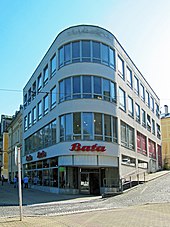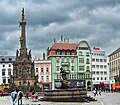Vladimír Karfík
Vladimír Karfík (born October 26, 1901 in Idrija , Austria-Hungary , now Slovenia , † June 6, 1996 in Brno ) was a Czechoslovak architect and university professor. From 1930 to 1946 he was the head of the project department at the Baťa company in Zlín . At the Faculty of Architecture of the Slovak Technical University (SVŠT) in Bratislava , he worked from 1946 mainly in the field of architectural theory . He was a representative of Czechoslovak modern architecture of the 20th century and designed various types of buildings, in particular industrial, administrative and sales buildings.
Live and act
Childhood and studies
Vladimír Karfík was born in Idrija (Slovenia) in the family of the Czech doctor František Karfík and his wife Hermína (née Gemperlová). In 1904 the family moved to Prague . After attending secondary school in Prague- Žižkov , he studied architecture from 1919 to 1924 at the Faculty of Architecture and Civil Engineering of the Czech Technical University in Prague and with Jan Kotěra at the Academy of Fine Arts in Prague . After completing his studies in 1925/26, he completed a study visit to Paris and worked as a draftsman for Le Corbusier , where he also met the architects Auguste Perret , André Lurçat and Adolf Loos .
Career in the interwar period
After returning to Prague, he worked as a designer in A. Belada's construction office in Prague. From 1927 to 1930 he worked in various architecture offices in the USA , including in Frank Lloyd Wright's studio in Taliesin East and Taliesin West , a pioneer of modern architecture in the USA. Here he got to know the current skyscraper projects. In Chicago he received an offer from entrepreneur Tomáš Baťa (1876–1932) based on his American experience to work in his Baťa company in Zlín .
In 1930 he married Jaroslava Žižková († 1946) and settled in Zlín. As an employee and later (thanks to his reputation as an employee of Le Corbusier and Wright) as head of the construction and design office of the Baťa company in the 1930s, he realized a number of very modern and functionally designed buildings both in Czechoslovakia and abroad. These include, for example, the administration building of the Baťa-Werke in Zlín (one of the first high-rise buildings in Europe), the Society House in Zlín (with the first European hotel room with bath and toilet, now Hotel Moskva), the Society House (three-wing building) in Otrokovice , Baťa- Department stores in Brno , Pressburg , Prague, Olomouc , Amsterdam and Borovo in Croatia as well as residential buildings in the Baťa colony in Zlín. He also designed churches in Bratislava, Zlín and Baťovany (now Partizánske ). The work in the construction and design office of the Baťa company in Zlín from 1930 to 1946 was an important phase in his life. At the beginning of his career in Zlín he worked on the project of the Baťa department store in Brno. Originally it was supposed to have 28 floors, but due to structural problems and Baťa's disagreements with the city council, it was limited to seven floors. Karfík was together with František Lydie Gahura (1891-1958) and Miroslav Lorenc (1896-1943) the founder of the urban and architectural tradition of Zlín, the so-called "Zlín architecture".
During his work at the Baťa company in the 1930s and 1940s, he also designed numerous villas in Zlín and the surrounding area, e.g. B. the Malota Villa, Čipera Villa and the Gerbec Villa. From 1931 to 1956 he was a member of the international association Congrès Internationaux d'Architecture Moderne (CIAM).
Post-war career
His activity as "house architect" for the Baťa company ended after the Second World War. From 1946 to 1950, together with Vladimír Kubečka, he developed the designs for the Fučík district ( Fučíkova čtvrť ) and the district administration building in Zlín. Vladimír Karfík left Zlín and went to Bratislava at the invitation of Emil Belluš , where in 1946 he was appointed professor of industrial, transport and administrative buildings at the Faculty of Architecture of the Slovak Technical University (SVŠT) in Bratislava. There he trained several generations of architects and contributed to the further development of Slovak architecture. From 1955 to 1957 he was dean of the faculty.
At the same time, he designed and implemented institute buildings for various universities, industrial buildings and office buildings as well as residential areas throughout Slovakia . In Nové Mesto nad Váhom he designed the first prefabricated house in what was then Czechoslovakia . In addition to his educational work, he also continued his design work (Faculty of Chemical Technology, Bratislava University of Technology, University of Economics, Faculty of Pharmacy, Comenius University Bratislava ).
In 1948 he married Elsa Melinová from Sweden, an assistant at the University of Bratislava, who went to Sweden in 1956 . In 1961 he married Světa Fialová. He was also a member of the Slovak Academy of Sciences (SAV) and was awarded the State Prize in 1956. His buildings are characterized by modern technical and design concepts.
retirement
After his retirement he worked from 1971 at the URBION Institute (State Institute for Urban Development and Spatial Planning) in Bratislava, where he held lectures and consultancy activities. From 1979 to 1983 he worked as a professor at the Faculty of Architecture and Civil Engineering at the University of Malta , where he presented several designs for buildings, including the project for a summer residence villa for the President of the Republic of Malta on the island of Gozo and an extension of the Museum of Fine Arts in Valletta . After his return from Malta he settled in Brno, dealt with the assessment of construction projects and was invited to lectures by various institutions. He published specialist books and articles for specialist journals and was also active in literature. In 1993 his memoir An Architect Remembers was published . He died in Brno in 1996 at the age of 95 and was extremely active and vital to the end. He was married three times and had four children.
Honors
In 1985 he was made an honorary member of the American Institute of Architects (AIA). In 1991 he received the Jurkovič Prize of the Association of Slovak Architects and an honorary doctorate from the Technical University of Brno and Technical University of Prague . He received honorary citizenship of the cities of Brno, Bratislava, Bystřice pod Hostýnem and Otrokovíce. The then President of the Czechoslovak Republic, Václav Havel , awarded him the ČSFR gold medal in 1992 . He also received the Medal of Honor from the Technical University of Prague (ČVUT) and was named “Shoemaker of Honor” for the Baťa company, for which he had built many buildings.
Buildings (selection)
- 1930/31: Roman Catholic Church in Bratislava- Petržalka , Daliborovo námestie
- 1931: OD Center in Brno, Kobližná 53/24
- 1931/32: Baťa department store in Liberec , nám. Soukenné 23/10 or Pražská 23/39
- 1932: Society house in Zlín, náměstí Práce 2512, now Interhotel Moskva (with Miroslav Lorenc)
- 1932: Baťa shoe store in Bratislava, Hurbanovo námestie 6
- 1932: Baťa shoe store in Marienbad , Dykova 144/1, Hlavní třída, demolished in 2016
- 1933–1938: Baťa department stores and Baťa shops in Chomutov , Olomouc , Teplice , Čáslav , Jihlava , Prague- Vysočany , Prague- Vršovice , Hustopeče , Bratislava, Piešťany , Trnava , Klatovy and Otrokovice
- 1931–1938: Two buildings in Ústí nad Labem - Baťa department store, Ústí nad Labem-Střekov, Varšavská 779/5 and "Dům Pečeť" ("Seal"), Ústí nad Labem, Velká Hradební 1260/3
- 1933: Baťa branches in Tilbury in England and Belcamp in the USA
- 1934–1937: Baťa department store in Amsterdam
- 1935–1937: Baťa shoe store in Teplice , U Císařských lázní 366/3
- 1935–1937: Evangelical Church in Zlín, Štefánikova
- 1935–1940: Film studios and film studios of the Baťa company in Kudlov near Zlín, Filmová 174
- 1935–1943: Villas in Zlín - Villa Bohuslav Ševčík (1935) (with Miroslav Lorenc), Villa Vladimír Karfík (1935), Villa Ludvík Gerbec (1936), Villa Josef Zavrtálek (1936), Villa Václav Rojt (1937), Villa Vojtěch Baťa (1940), Villa Josef Hlavnička (1941), Villa Hugo Vavrečky (1941), Villa Dominik Čipera (1942), Villa František Malota (1943)
- 1936: Society house and hotel in Otrokovice, tř. Spojenců 727 / Tylova
- 1936–1938: Administration building of the Baťa works in Zlín, called “Skyscraper” ( Baťův mrakodrap ), třída Tomáše Bati No. 21, now the district administration
- 1938–1939: Pálka villa in Liptovský Mikuláš (with Adolf Benš)
- 1938–1943: Baťa works and housing estate in today's Partizánske (formerly Baťovany)
- 1940: Roman Catholic Church in today's Partizánske (formerly Baťovany), Námestie SNP 1475/34
- 1941: Baťa shoe factory in Borovo in Croatia
- 1946: Housing estate "Fučík-Quartier" ( Fučíkova čtvrť ) in Zlín (with Vladimír Kubečka)
- 1946–1948: indoor swimming pool in Zlín (with J. Holeček)
- from 1947: factory and housing estate in Bratislava
- 1947–1949: Faculty of Chemical Technology SVŠT in Bratislava
- 1950: Administration building (former district administration) in Zlín, třída Tomáše Bati 3792 (with Vladimír Kubečka), now ČSSZ Zlín (Czech Social Insurance Administration)
- 1950: House of Culture in Senica in Slovakia
- 1950/51: Bus garage in Bratislava
- 1953–1955: University of Economics and Faculty of Pharmacy at the University of Bratislava (with A. Rokošný)
- 1956: First experimental large panel construction in Czechoslovakia in Bratislava, Kmeťovo námestie 2796/5
- 1963: VÚMA building (Research Institute for Mechanization and Automation) in Nové Mesto nad Váhom (with A. Rokošný)
- 1969: Martimex office building (company for foreign trade) in Martin
- 1971–1978: former Institute for Applied Cybernetics (SAV) in Bratislava (with Jan Komrska)
- 1974: own house in Brno, Barvičova 870/58
- 1977: Expansion of the Comenius University in Bratislava
- Buildings of the Technical University of Bratislava on Kollárov Square
- 1982: Extension of the Museum of Fine Arts in La Valletta on Malta (with Ed. Mintoff)
Gallery of his buildings
literature
- Vladimír Karfík: Architekt si spomína (An architect remembers - biography), SAS Bratislava, 1993, Czech, ISBN 978-8-09004-834-8
- Karin Šrámková: Architect Vladimír Karfík 1901–1996, diploma thesis (Czech), Masaryk University Brno, 2006, 79 p., See [1]
- Andreas Barz: Czechia's Utopia and the boot of dictatorship, 2010, kunsttexte.de, 1/2010, pp. 1–5, see [2]
Web links
Individual evidence
- ↑ Archiweb - Vladimír Karfík (Czech) (accessed July 8, 2020)
- ↑ Zlín.estranky - Vladimír Karfík (Czech) (accessed July 8, 2020)
- ^ Brno Architecture Manual (BAM) - Vladimír Karfík (accessed July 8, 2020)
- ↑ Vladimír Karfík. In: arch INFORM .
- ↑ Arch-Pavouk: Vladimír Karfík (Czech) (accessed July 8, 2020)
- ↑ Baťa history (Czech) (accessed on July 8, 2020)
- ↑ a b Zlínská Architektura - Vladimír Karfík (Czech) (accessed July 8, 2020)
- ↑ Zlínský architektonický manuál (ZAM) - Vladimír Karfík (Czech) (accessed July 8, 2020)
- ↑ Architecture in Northern Bohemia - Vladimír Karfík (Czech) (accessed July 8, 2020)
- ↑ Architecture in Northern Bohemia - Baťa Department Store in Liberec (Czech) (accessed July 8, 2020)
- ↑ Architecture in Northern Bohemia - Baťa Aussig Department Store (accessed July 8, 2020)
- ↑ Architecture in Northern Bohemia - Dům Pečeť (accessed July 8, 2020)
- ↑ Architecture in Northern Bohemia - Baťa commercial building in Teplice (Czech) (accessed July 8, 2020)
| personal data | |
|---|---|
| SURNAME | Karfík, Vladimír |
| BRIEF DESCRIPTION | Czech architect |
| DATE OF BIRTH | October 26, 1901 |
| PLACE OF BIRTH | Idrija , Slovenia |
| DATE OF DEATH | June 6, 1996 |
| Place of death | Brno |






















